Navigating social interactions in Japanese requires more than just knowing the right words—it requires understanding the cultural context behind them. Learning how to say no in Japanese politely is essential for anyone studying the language, as the direct translation of “no” rarely captures the nuance needed in real conversations.
In Japan, direct refusal can be seen as confrontational or disrespectful. Instead, Japanese culture values harmony (和 – wa) and face-saving communication that preserves relationships. This is why knowing how to say no in Japanese politely involves mastering indirect expressions and softening techniques that communicate refusal without causing offense.
Basic Ways to Say No in Japanese
Before diving into the polite expressions, let’s quickly cover the basic terms for “no” that you might encounter in textbooks:
| Japanese | Romaji | Politeness Level | Usage |
|---|---|---|---|
| いいえ | Iie | Formal | Written forms, corrections |
| いえ | Ie | Semi-formal | Softened corrections |
| いや | Iya | Casual | Among friends |
While these are technically correct, using them alone often comes across as abrupt or even rude in many situations. Learning how to say no in Japanese politely means rarely using these words by themselves.
5 Polite Ways to Say No in Japanese
1. すみません、ちょっと… (Sumimasen, chotto…)
“I’m sorry, it’s a bit…”
This is perhaps the most common polite way to say no in Japanese. By saying “chotto” (a little) and trailing off, you indirectly communicate that something is difficult without explicitly refusing.
Example:
- Friend: 今晩、飲みに行きませんか? (Konban, nomi ni ikimasen ka?) “Would you like to go drinking tonight?”
- You: すみません、ちょっと… (Sumimasen, chotto…) “I’m sorry, it’s a bit…”
The beauty of this phrase is in its deliberate ambiguity. The listener understands your meaning without you having to directly say “no.”
2. 申し訳ありませんが、難しいです (Mōshiwake arimasen ga, muzukashii desu)
“I apologize, but it’s difficult”
When you need to be clearer but still maintain politeness, this phrase communicates a definite “no” while expressing regret.
Example:
- Colleague: 明日の会議で発表していただけますか? (Ashita no kaigi de happyō shite itadakemasu ka?) “Could you make a presentation at tomorrow’s meeting?”
- You: 申し訳ありませんが、明日は難しいです。 (Mōshiwake arimasen ga, ashita wa muzukashii desu.) “I apologize, but tomorrow would be difficult.”
3. 今回は遠慮させていただきます (Konkai wa enryo sasete itadakimasu)
“I will refrain this time”
This highly formal expression is perfect for business settings or when dealing with superiors. It communicates that while you cannot accept now, you might be open to similar opportunities in the future.
Example:
- Boss: このプロジェクトのリーダーになってもらえますか? (Kono purojekuto no rīdā ni natte moraemasu ka?) “Could you become the leader of this project?”
- You: 誠に恐れ入りますが、今回は遠慮させていただきます。 (Makoto ni osore irimasu ga, konkai wa enryo sasete itadakimasu.) “I truly apologize, but I will refrain this time.”
4. ご親切にありがとうございますが… (Go-shinsetsu ni arigatō gozaimasu ga…)
“Thank you for your kindness, but…”
When someone offers you something, this phrase acknowledges their generosity before declining, making your refusal sound more gracious.
Example:
- Host: もっとお茶はいかがですか? (Motto ocha wa ikaga desu ka?) “Would you like more tea?”
- You: ご親切にありがとうございますが、十分です。 (Go-shinsetsu ni arigatō gozaimasu ga, jūbun desu.) “Thank you for your kindness, but I’ve had enough.”
Want to explore Japan’s culture?
Discover Japan’s rich culture, traditions, and hidden gems with our expertly crafted guides. Get insider tips on travel, food, and history. All for free!
5. また今度お願いします (Mata kondo onegaishimasu)
“Please another time”
This phrase softens rejection by suggesting future acceptance, making it perfect for social invitations.
Example:
- Friend: 週末に映画を見に行きませんか? (Shūmatsu ni eiga o mi ni ikimasen ka?) “Would you like to go see a movie this weekend?”
- You: ありがとう、でも今週末は予定があるので、また今度お願いします。 (Arigatō, demo kon-shūmatsu wa yotei ga aru node, mata kondo onegaishimasu.) “Thank you, but I have plans this weekend, so please another time.”
Context Matters: When and How to Use These Phrases
The most appropriate way to say no in Japanese politely depends heavily on the situation. As we discussed in our article about Japanese dialects, regional variations can also affect how refusals are perceived.
Work Environment
In professional settings, formality is key. Phrases that express regret and maintain respect are essential. Similar to the intricate customs seen in traditional Japanese funerals, business etiquette has specific protocols for refusal.
Use: 申し訳ありませんが、難しいです or 今回は遠慮させていただきます
Social Invitations
When friends invite you somewhere, softer refusals work better. Just as rakugo storytelling uses subtle techniques to engage audiences, your refusals should maintain the relationship while communicating your unavailability.
Use: すみません、ちょっと… or また今度お願いします
Offerings and Gifts
When declining offers of food, drinks, or gifts, always acknowledge the generosity first. This shows respect similar to how Shichi Go San celebrations honor traditional values while embracing modern sensibilities.
Use: ご親切にありがとうございますが…
Body Language: The Silent Component of Japanese Refusal
Saying no politely in Japanese goes beyond words. Pay attention to these non-verbal cues:
- Slight head tilt while declining (not nodding or shaking)
- Hesitant tone that suggests reluctance to refuse
- Apologetic facial expression to convey regret
- Avoiding direct eye contact to soften the refusal
Common Mistakes to Avoid
When learning how to say no in Japanese politely, foreign speakers often make these errors:
- Being too direct – Using a simple “いいえ” (iie) without softeners
- Forgetting to apologize – Missing the crucial expression of regret
- Not providing alternatives – Closing the door completely rather than suggesting another option
- Using inappropriate politeness levels – Matching your language to the situation is crucial
Ready to Master Polite Japanese Communication?
Understanding how to say no in Japanese politely is just one aspect of becoming fluent in this nuanced language. If you’re ready to take your Japanese skills further, our comprehensive Learn Japanese program offers free guides to help you navigate these cultural complexities with confidence.
The simplest answer to how to say no in Japanese politely is to use “すみません、ちょっと…” (Sumimasen, chotto…) in most casual situations.
FAQ: Politely Saying No in Japanese
What is the most polite way to refuse something in Japanese?
The most polite refusal in Japanese is “申し訳ありませんが、難しいです” (Mōshiwake arimasen ga, muzukashii desu), which expresses sincere regret while communicating that something cannot be done.
Can I just say “いいえ” (iie) to say no in Japanese?
While “いいえ” is technically correct, using it alone is often considered too direct and potentially rude. It’s better to use softening expressions and indirect refusals in most situations.
How do Japanese people decline invitations without being rude?
Japanese people often use vague expressions like “ちょっと…” (chotto…) or suggest an alternative time with “また今度” (mata kondo) to decline invitations while maintaining harmony.
Is body language important when refusing in Japanese?
Absolutely! A slight tilt of the head, apologetic facial expression, and avoiding direct eye contact all help soften a verbal refusal in Japanese culture.
How does refusal differ between business and casual settings in Japan?
Business refusals require higher levels of formality and explicit expressions of regret, while casual refusals can be more indirect and suggest future acceptance.
Looking to improve your Japanese language skills? Check out our complete guide to Japanese college uniforms to understand another fascinating aspect of Japanese culture!
Love Japan? Stay in the Loop!
Get the best of Japan straight to your inbox: language, culture & travel insights!




